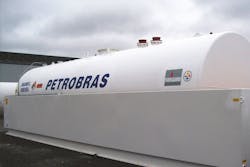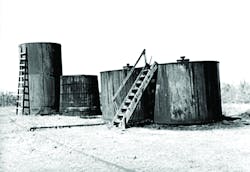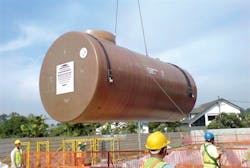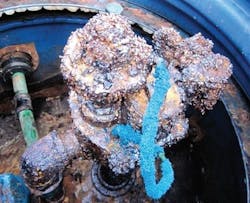Tank storage has come a long way since wooden oil storage tanks were used in the early 20th century. From its founding in 1916, the Steel Tank Institute (STI) has developed tank designs according to concepts that are now common requirements in all national tank standards and regulations: corrosion control for underground tank systems (USTs), secondary containment for USTs and above-ground tank systems (ASTs), and fire protection for ASTs.
Old wooden storage tanks
These technologies evolved in response to regulatory, fire, environmental and safety codes developed by governmental oversight agencies and standard-setting organizations. STI is in its 100th year as one of those standard-setting bodies, having developed standards and specifications for nine different tank technologies to meet the needs of the industry and consumers.
Most owners and specifiers prefer purchasing tanks that are built to national standards. These standards have been developed through a consensus process among industry and regulatory experts. Their goal is to create tank technologies that are safe, high quality, corrosion resistant and long lived.
Storing flammable & combustible liquids
This article discusses only metallic atmospheric storage tanks for flammable and combustible liquids. They are either shop fabricated, meaning completed in a manufacturing facility, or field erected, meaning components are delivered to a site at which the tank is constructed.
The following are the primary tank standards used in the U.S. Purchasers should seek tanks that meet these standards.
Atmospheric flammable & combustible liquid storage USTs
UL 58 applies to single- and double-walled USTs, usually cylindrical in shape. These tanks are commonly used to store fuel at retail stations.
UL 1746 specifies that underground tanks must be protected to prevent corrosion damage that could lead to fuel leaking into the soil. Methods include a jacketed tank [(interstice layer and coating of fiberglass reinforced plastic (FRP) or high-density polyethylene (HDPE)]; composite tank (FRP bonded to steel); and cathodically protected tanks [more easily corroded anode (of zinc or magnesium) sacrifices itself to protect steel from corroding at flaws in the coating on the tank surface].
UL 1316 is the comparable standard for tanks made from FRP.
Atmospheric flammable & combustible liquid storage ASTs
UL 142 covers tanks that are single- or double-walled, wrapped or diked, vertical or horizontal, and cylindrical or rectangular. Vertical tanks are often seen at bulk plants and tank farms. Most large fleet storage uses horizontal, cylindrical tanks. Rectangular tanks are most often used for lube oil, generator base tanks and work benches.
UL 2085 covers double-walled tanks only (the inside tank is built to UL 142). UL 2085 tanks must be insulated to withstand a temperature of 2,000°F for two hours, comparable to the insulation provided by the soil for an underground tank. Some fire codes mandate the use of this type of tank for aboveground motor vehicle fuel storage.
Non-STI labeled, double- and single-walled ASTs built to UL 142 and UL 2085 likely number in the millions since welded tank technology began in the 1930s.
Tank materials
Carbon steel is the most abundantly produced of all steel products and the most commonly used tank material. Stainless and duplex steels are metal alloys of steel with varying amounts of chromium, nickel and other elements added. Unlike other metals, stainless steel does not rust or corrode in most applications. It is used primarily in pressure vessels, chemical processing, petroleum refining and any application for which sterile conditions are needed – such as for food, ethanol and biodiesel processing.
FRP is a composite material made of a polymer matrix reinforced with fibers, usually of glass. FRP is used primarily for USTs that store motor vehicle fuels. It is also used to wrap steel tanks for corrosion protection and secondary containment.
Current issues pertaining to fuels & atmospheric tanks
The fuel storage tank industry is exploring two important issues of which prospective buyers should be aware: biofuels and compatibility as well as ultralow sulfur diesel and corrosion.
Biofuels & compatibility
Since the advent of ethanol-blended gasoline, concern has existed regarding the compatibility of traditional steel storage tanks with ethanol and newer fuels. Biofuels have significantly different characteristics from petroleum gasoline and diesel. Noteworthy are their higher solubility and water-absorption capacity compared to conventional fuels.
Blended gasoline and ethanol’s higher solubility can mobilize sludge in tanks, clogging filters and other equipment. Higher solubility can also allow ethanol and biodiesel to degrade hoses, gaskets and seals made from elastomerics and plastics under prolonged exposure. For older FRP tanks, it’s important to verify with the manufacturer that the resin used is compatible with today’s higher-concentrated ethanol-fuel-blended gasoline, such as E15 and E85.
Ethanol and biodiesel also have the capacity to absorb more dissolved water than conventional gasoline or diesel. This property can lead to phase separation, which occurs when alcohol (ethanol) exits the fuel phase and enters the aqueous phase. The separated water can increase the activity of microbes whose byproducts accelerate pitting corrosion.
Ultralow sulfur diesel & corrosion
Corrosion related to ultralow sulfur diesel has been an ongoing source of concern since 2007. From 2014 to 2015, the U.S. Environmental Protection Agency (EPA) conducted a field study1 of 42 in-service tanks. The study assessed tanks constructed of both steel and fiberglass located throughout the U.S. Based on a scale developed by the Coordinating Research Council, “extreme corrosion” was seen in 11 FRP and seven steel tanks; “moderate” corrosion was seen in nine FRP and eight steel tanks; and “minimum” corrosion was seen in four FRP and three steel tanks.
Until recently, whether corrosion was also attacking metallic components inside steel tanks, in addition to inside FRP USTs was uncertain. Documented incidents previously were entirely of corrosion that occurred on components inside tanks, and usually inside fiberglass tanks. The EPA study, however, used a video camera to go inside in-service tanks. The video revealed this corrosion is a much more widespread problem than first thought.
The corrosion of metal equipment inside USTs, regardless of tank material, is unique in that it appears to first develop in the vapor area of the tank and then continues into the fuel space and into the water on the tank bottom as well. This matter is still being researched to better understand the cause.
Corrosion in an STP sump
Water
Finally, all fuel storage tanks, no matter what their material of construction or what they store, must be kept free of water. This point must be emphasized. Not only does water oxidize steel and create rust, but it is also a breeding medium for microbes that create waste products detrimental to internal tank equipment. In addition, water and microbial byproducts contaminate the stored product, with consequent economic impact.
STI developed the R111 Recommended Practice for Storage Tank Maintenance2 for UST owners and operators as well as a brochure3 emphasizing the importance of keeping water out of underground tank systems. Both are available for download from the STI website.
For AST systems, STI provides the SP001 AST Inspection Standard. Developed through a consensus process by industry experts and stakeholders, SP001 is widely used by AST petroleum storage tank owners to help them comply with EPA regulations for spill control.4
References
- EPA’s Investigation of Corrosion-Influencing Factors in Underground Storage Tanks with Diesel Service, http://www.epa.gov/sites/production/files/2016-07/documents/diesel-corrosion-report_0.pdf
- STI’s R111 Recommended Practice for Storage Tank Maintenance, http://www.steeltank.com/Portals/0/Shop%20Fab/R111%20%20with%20updated%20cover.pdf
- STI UST maintenance brochure, http://www.steeltank.com/Portals/0/Shop%20Fab/2016%204%20fold%20UST%20maintenance%20FOR%20WEB%202.pdf.pdf
- STI SP001 Standard for the Inspection of Aboveground Storage Tanks http://www.steeltank.com/SP001StandardFAQs/tabid/463/Default.aspx
Wayne Geyer is executive vice president of the Steel Tank Institute-Steel Plate Fabricators Association (STI-SPFA) and has been employed by STI since 1985. Geyer participates regularly in conferences addressing underground and aboveground storage systems for hazardous liquids. He is a professional engineer and a member of the National Fire Protection Association’s 30 Flammable and Combustible Liquids Code Committee. In addition to STI’s own standard-setting efforts, he is active in other organizations’ standards development processes. Geyer expands his advocacy role by participating in state and national regulatory rule-making programs and code development. STI-SPFA is a not-for-profit trade association representing fabricators of steel construction products and their suppliers. The association is celebrating its 100th anniversary in 2016. Member companies produce steel storage tanks, field-erected water tanks, pressure vessels and heat exchangers, and pipe and pipelines. Their customers are from the petrochemical, power generation, food, pharmaceutical, fuels, wastewater and water transmission industries. For information about STI’s tank technologies, visit its website or email [email protected].




